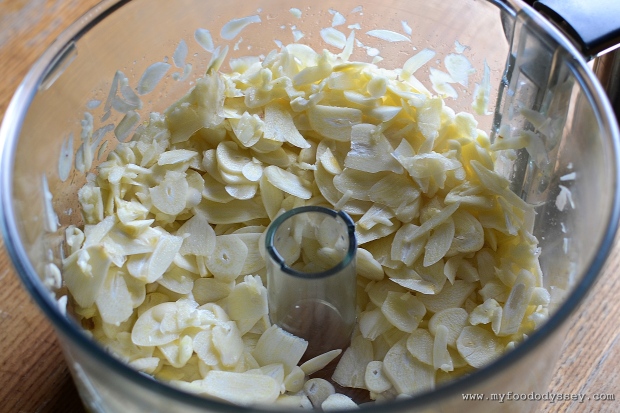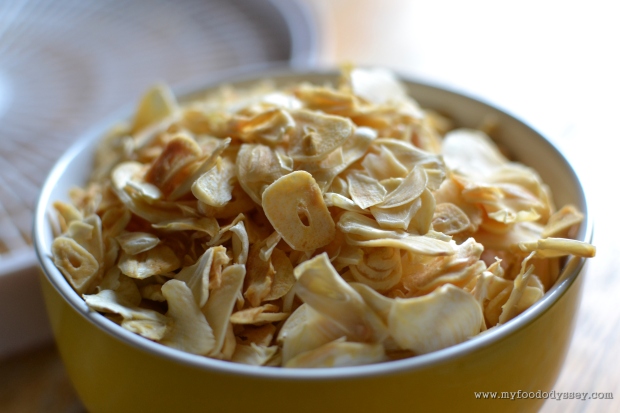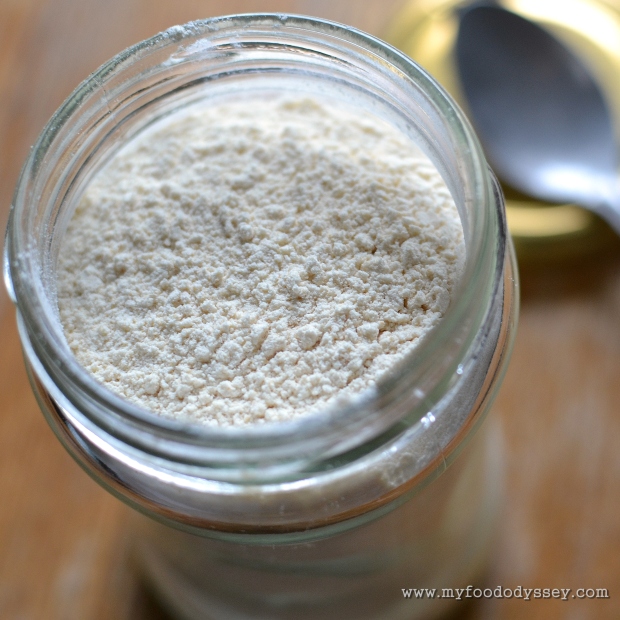Homemade Garlic Powder [Recipe]

I absolutely love garlic as an ingredient. I use tons of the stuff – pretty much every savoury dish I prepare contains at least one clove of garlic, probably more. Garlic seems to add so much to a dish – rich aroma, warmth, luxury, a touch of heat and a depth of flavour that seems to linger on the palate long after you’ve finished eating. For me, no other seasoning comes close to garlic.
There was a time using garlic was the preserve of French cooking and having garlic breath implied you had eaten someplace “posh” the night before. Garlic was expensive to buy and few knew how to use it. In my copy of “The Vegetable Expert”, published in 1985, Dr. D.G. Hessayon tells us that garlic “has an important role in Continental but not in British cookery – it really isn’t worth growing unless you are a fan.” However, he also tells us that the culinary uses of onions “are so varied and the basic ways of employing [them] so well know that there would be no point in trying to list them.”


Things have come a long way in the last twenty years and garlic is now almost as ubiquitous as onions. It is relatively inexpensive, although still a little overpriced in supermarkets. Here in Lithuania, everyone seems to grow garlic and it is very cheaply available in the farmers’ markets. I can buy a kilo of garlic (about 20 full heads) for just €2.30.
I am also trying to grow my own this year using cloves that sprouted over the winter. I have planted about 60 cloves, which I hope will be enough to supply my garlic needs over the coming winter plus enough to use for seed next year. With any luck, I’ll never need to buy garlic again.

For all my love of garlic there are times when using fresh garlic just doesn’t suit, either because I’m in a hurry or because sliced or even finely chopped garlic won’t work in the dish. Using fresh garlic doesn’t work in burgers or meatballs – no matter now finely you chop the garlic it doesn’t seem to cook through. Raw garlic is very overpowering and not very pleasant. Equally unpleasant is burnt garlic, which has a very bitter taste. I find if I use raw garlic in burgers, little pieces of garlic around the edges crisp up or burn, ruining the delicious meaty flavour of the burger.
My solution is to use garlic powder in my mincemeat dishes. Used judiciously, it melts into the meat along with the other seasonings, adding that deep umami taste without being distinctively garlicky. As well as use in burgers and meatballs I also use garlic powder in Lithuanian koldunai, my fajita seasoning (recipe coming soon), my potato wedge seasoning, my aioli and multiple other dishes.

When I lived in Ireland I used to buy garlic powder at my local Asian market. It was quite inexpensive and tasted fine, but I always wondered what other ingredients it might contain and was slightly uncomfortable using garlic shipped half way round the world when we grew perfectly good garlic at home. A few months back I bought myself a dehydrator* and one of the first things on my list to make was garlic powder. It was incredibly simple and worked out perfectly. I now have a plentiful supply of a product that I know contains nothing, but nothing, but garlic.

I appreciate that home dehydrating is a relatively new phenomenon and that few people will have a dehydrator* at home. If, like me, you are trying to eliminate industrially processed foods from your diet that I can’t recommend them highly enough. They are cheap to buy and cheap to run, using very little electricity. As well as for garlic I have so far used mine for onion powder, sweet paprika, dried fruit such as pineapple, kiwi and apple, dried herbs such as rosemary and thyme, and dried citrus rinds for use in baking. I have many more uses in mind and will be experimenting over the coming months.

HOMEMADE GARLIC POWDER
I can’t really call this a recipe, but here are some guidelines for dehydrating garlic:
- To get the best value from your dehydrator*, dehydrate in large batches. A four-tray dehydrator will take about 10 heads of garlic (approx 500 g) at a time.
- Slice the garlic as finely as possible. I use my food processor for this, ensuring that the slices are both thin and consistent. If you don’t have a food processor you can slice by hand. Try to ensure that the slices are as consistent as possible so that they dehydrate in the same amount of time.
- Spread the garlic in a single layer across the dehydrator trays. A small amount of overlap is ok as they will shrink as they dehydrate, but try not to have slices stacked on top of each other as this will interfere with the drying process.
- I use a temperature of 58 degrees Celsius, which is labelled as the “Fruit & Vegetables” setting on my dehydrator. The exact temperature is not important – anything from 50-60 degrees Celsius should work fine.
- Dehydrating takes quite a long time. This amount of garlic will take roughly 12-18 hours, depending on the temperature and humidity of your home and how finely you sliced the garlic. I frequently do it over two days, turning the machine off at night and back on again the next morning.
- The garlic needs to be completely dry. It should snap cleanly and easily, with no rubbery “give” whatsoever. If the garlic is not completely dry it will clog your grinder and will not keep well.
- Once you are happy that your garlic is completely dry you need to grind it into powder. I use my coffee grinder for this, half-filling the grinder in batches. You can also grind using a pestle and mortar. Because the garlic is so dry it actually grinds very easily, so it doesn’t take much strength to do it by hand.
- (Tip: to clean your grinder after grinding the garlic, first wipe it as clean as possible with a dry paper towel, the grind a small handful of rice. The rice gathers up any residual garlic and helps eliminate the garlicky smell. Throw away the powdered rice and give one final wipe with a fresh piece of kitchen paper.)
- Transfer your garlic powder to a clean, completely dry jar. It will store for several months.
- 500 g of garlic (about 10 heads) yields approximately 1 jar (185 g) of garlic powder.
- 1 teaspoon of garlic powder is approximately equivalent to 3 medium cloves of garlic.
Note that onion powder can be prepared in exactly the same way. Because of their higher water content the yield from onions is lower than from garlic – it takes about 1 kilo of onions to produce 1 jar of onion powder. Like garlic powder, onion powder is incredibly useful as an ingredient and is a fantastic pantry staple.
* If you don’t have a dehydrator, please see comments section for how to make garlic powder without a dehydrator.
Like what you see? Then please subscribe to My Food Odyssey. Alternatively you can follow me on Facebook, Twitter and Pinterest.




Leave a reply to June Cancel reply
This site uses Akismet to reduce spam. Learn how your comment data is processed.































If its ground too fine it gets cakey. That has happened to me and too much comes out when i shake it out of the shaker. I was wondering if there was something i could add to it to make it more pourable, Thanks so much
LikeLiked by 1 person
This is not really one you’d put in a shaker, Linda. A shaker would be more suitable for garlic granules or garlic salt. This one is meant to be a fine powder so that it disperses very evenly through the food or sauces with no lumps. I would keep it in a regular jar and use a teaspoon or measuring spoon to take out the exact amount I need.
LikeLike
Thank you for getting back to me so soon. I will do as you suggest. Thanks again
LikeLike
Muchas gracias…me sirvió mucho tu experiencia en deshidratar alimentos..suerte!
LikeLiked by 1 person
What if i dont have a dehydrater?
LikeLike
See comments below!
LikeLike
Can I dehydrate without dehydrator, how?
LikeLike
Hi Suparna. Yes, you can do it without a dehydrator. Slice the garlic as thinly as possible and thread the slices onto lengths of white thread, then hang the threads someplace warm to dry. I would suggest hanging them horizontally rather than vertically so that you can keep a little space between the individual pieces of garlic. They should dry in a few days. Test a piece by breaking it in two – it should snap, not bend. Hope that helps! June.
LikeLike
Is there a way to dehydrate without a dehydrator?
LikeLiked by 1 person
There’s a few ways you can do it, Cheryl. All start the same way – peeling the garlic and slicing as thin as you can. The thinner the slices the more quickly and evenly it will dry. One method is to string the slices together with a needle and thread, ideally leaving small gaps between pieces, and then hang the string between two points like a Christmas garland. The garlic should dry within a few days. Alternatively you can arrange the slices on kitchen towels, cover with another towel and leave in a warm place – even outside (as long as the cover doesn’t blow off!) Again, they should dry within a few days. Make sure the pieces snap when bent before you grind them or your powder will be damp and may stick together in clumps. Hope that helps! June.
LikeLike
I’d never even heard of a hyrator until I read your post, so I’m off hot-foot to see if I can see one before ordering from Amazon (I need to know where it will fit in my space-limited’ kitchen. Sounds as thought I’ll get a lot of use out of it, although I grow fresh herbs in abundance in my garden so don’t need to dry these (I plant them up for winter use indoors as well), but I love the sound of it. My nephew has just bought a smoker and is into smoking everything at the moment. Smoked salt is his most recent and I must admit, it did lend quite a different taste to the dishe he prepared.
LikeLiked by 1 person
I do use mine quite a bit, Mari. I do big batches of onion and garlic a few times per year, wild mushrooms in August and September (we are lucky enough to find porcini mushrooms in our local forest), wild garlic (ramps) when I can find them, a large portion of our cherries to use in granola, carrot pieces and peas for soup mix if I have a glut, and so on. If you grow fruit or veg or have access to a good farmer’s market where you might get a glut of something at a particular time of year only, then they are really useful. I love the idea of smoking salt! I’ve heard of smoked salt before but for some reason never thought of trying it myself. Must give that a go!
LikeLike
Great post June, I’ve also wanted a dehydrator for an age. Which one did you buy? I just can’t make my mind up which one to get…..
LikeLiked by 1 person
Hey Karen. I bought a supermarket own-brand one, but it looks incredibly like this one, to the point that I’d say they were made by the same company. For me, things to look for were the ability to add or remove trays, the inclusion of a solid plastic tray for drying liquids or purees and a top-down fan as food will fall down through the cracks. Mine is fairly sturdy with a simple temperature dial on the top and a little chart indicating the best temperature for various food types such as meat, vegetables, herbs, etc. I got mine on sale at half price – it was €30. I didn’t want to pay too much until I saw how much I used it but to be honest I wouldn’t change it – it does everything I need and is so simple to use. I suggest keeping an eye in Lidl or Aldi – if they do one, it’s likely to be fine for the money.
Hope that helps!
LikeLike
I’ve been thinking of getting a dehydrator You’ve convinced me it would be a good buy. But my husband wouldn’t ever let me grind garlic in his coffee grinder! 🙂
LikeLiked by 1 person
I wouldn;t let you put garlic in my coffee-grinder, either, because I’m a coffee lover too! Garlic and coffee should be kept well apart. Enjoy both and good eating and drinking.
LikeLiked by 1 person
You’re absolutely right – the grinder (and your coffee!) would never be the same again. You would really need separate grinders – one for coffee and one for spices. 😉
LikeLike
How clever. I have to admit that I live near lots of Asian shops that sell it in enormous bags but I see what you mean about air miles…
LikeLiked by 1 person
The big bags in the Asian shops are definitely tempting (and good value compared with supermarkets) but now that I have my dehydrator and a cheap (or free!) source of fresh garlic I’ll stick with the local stuff!
LikeLike
I love garlic, and garlic powder is such a handy thing to have around. I have never thought about making it myself, but I will have to try!
LikeLiked by 1 person
Thanks for the post! Very Interesting! I will look into buying a dehydrator!
LikeLiked by 1 person
I love garlic 🙂
As an aside, are you also growing ginger? I bet that would work well in the dehydrator! Oooooh, ginger biscuits!
LikeLiked by 1 person
I haven’t planted any ginger yet. Somehow I thought it wouldn’t grow here, but really haven’t a clue – must look into it. I use tons of gingers, too – both fresh and dried – so would love to have my own supply. And damn you for mentioning ginger biscuits – now that’s all I can think of!
LikeLike
It grows really well in the UK, all you need to do is stick one of those rhizome things in the ground. I’m sure it’d do just fine in Lithuania.
I’ll be waiting right here for my biscuits…
LikeLiked by 1 person
We use garlic powder as a natural wormer for the hens and pigs too! Just add a bit to their feed or water!
LikeLiked by 1 person
I’d read something about garlic being good for chickens, Margaret, and was wondering how I’d get it into them – this sounds like a great idea. Thanks!
LikeLike
Mix some in with their feed… we give them barley with some whey in it and the garlic powder. Or alternatively put it (and cider vinegar) in their water. How are the hens doing?
LikeLiked by 1 person
I tried some garlic in the water and it seems to have gone down fine – they’re certainly drinking it! My girlies seem to be thriving – they’re getting bigger and bigger. What does the cider vinegar do?
LikeLike